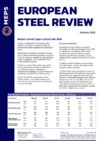UK budget brings some clarity to steel sector
The United Kingdom’s economic budget brought a degree of clarity for steel market participants eager to learn whether the new government’s plans will drive an uptick in demand.
Chancellor Rachel Reeves confirmed plans to launch the UK’s carbon border adjustment mechanism (CBAM) in 2027 in her October 30 budget speech in Parliament. The industry body UK Steel has since restated its fears that the decision not to align with the EU scheme’s 2026 rollout will leave the nation exposed to more carbon intensive imports for a 12-month period.
- Regular UK steel market insight is featured in MEPS International's European Steel Review. The monthly publication also features commentaries, steel prices, indices and forecasts covering other key markets across Europe. Contact MEPS for details of how to subscribe.
Other initiatives set out by the Chancellor indicated an increase in public spending aimed at boosting the country’s economy.
The budget announcement revealed a change in the fiscal rules which would allow billions of pounds to be released for infrastructure spending. Alterations in the way debt is measured will allow additional investment to be allocated, she told Parliament.
Up to GBP50 billion in government funds will be available to invest in new construction projects. This will include roads, railways, bridges and hospitals.
As part of their election manifesto, the UK’s ruling Labour party stated its intent to prioritise green initiatives – including the creation of new onshore and offshore wind farms – during their term in office. This is expected to result in an increase in the demand for hot rolled plate, particularly.
Automotive sector slowdown
Many market participants expressed their reservations about how much they will benefit from this, however. MEPS respondents say that material is being imported due to a lack of fabricating facilities in the UK.
A significant drop in domestic automotive production in recent years was recently highlighted at a joint meeting of the North Eastern Association of Steel Stockholders (NEASS) and International Steel Trade Association (ISTA). Some steel market participants argue that the transition towards electric vehicle (EV) production has been too quick.
UK car manufacturing volumes were down by 10.2% year-to-date at the end of September (at 592,862 units). The Society of Motor Manufacturers and Traders (SMMT) attributed the reduction to the wind-down of production of current models and retooling of lines for new EV models.
Nonetheless, the SMMT welcomed the UK government’s budget commitment of GBP2bn in “automotive transformation funding” as part of its modern Industrial Strategy.
This budget announcement, and those targeting new infrastructure spending, should encourage more positive sentiment among steel market participants.
2024 trading ‘worse than anticipated’
Speaking prior to the budget, NEASS and ISTA members said that 2024 had been “worse than anticipated”. They reported poor demand from many steel-consuming sectors. Many participants reported that they were hopeful of a modest demand improvement next year, however.
The building of new data centres gave particular cause for optimism. One MEPS source, from the sections and beams market segment, described such developments as a “bedrock and saviour” for years to come.
The elevated cost of borrowing will continue to weigh heavily on both public and private sector investments. The Bank of England cut interest rates by 0.25 percentage points (to 5%) in August. The Financial Times this week reported that 90% of economists it surveyed expected a announce a further cut on Thursday (November 7).
However, MEPS’s UK research partners say that falling interest rates have yet to have any effect on demand. They say that it is taking time for the improved access to finance to filter through the steel supply chains.

Source:
European Steel Review
The MEPS European Steel Review is an informative, concise and easy-to-use monthly publication, offering unique professional insight into European carbon steel prices.
Go to productRequest a free publication





